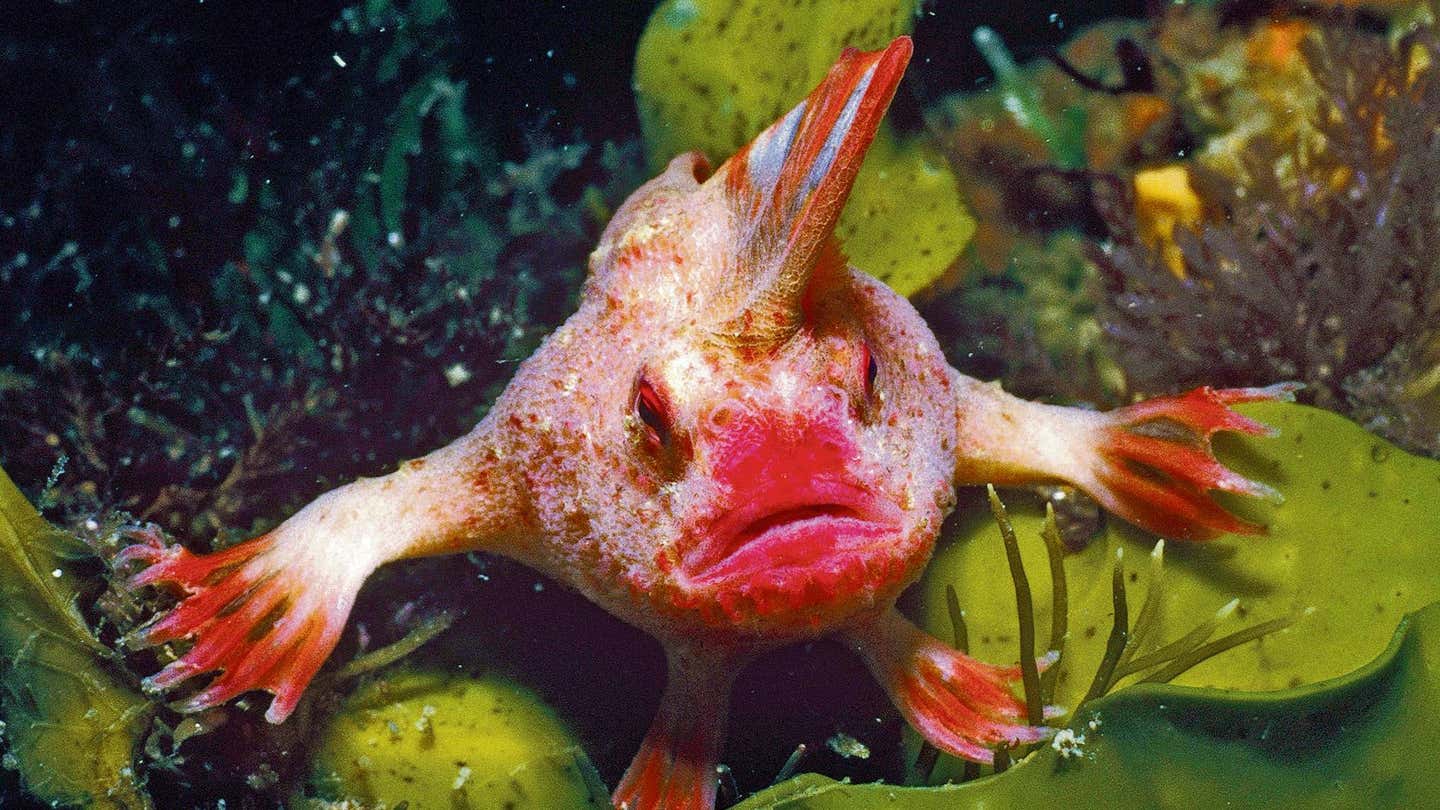Extremely rare fish species with hands instead of fins to be saved from extinction
Red handfish lack of a swim bladder, a common organ in most fish used to control buoyancy. Instead, they rely on their large hand-like fins.

Red handfish lack of a swim bladder, a common organ in most fish used to control buoyancy. Instead, they rely on their large hand-like fins. (CREDIT: Creative Commons)
The already critically endangered population of red handfish has seen a concerning decline. The wild population, which once numbered around 100 individuals, has dwindled to just 75.
This change is due to the removal of 25 red handfish individuals, who were taken into the care of the Institute for Marine and Antarctic Studies (IMAS) in Australia. Conservationists acted swiftly, obtaining special permission from the Australian government to relocate these individuals from their natural habitat.
Red handfish, unique members of the anglerfish family, distinguish themselves in various ways. One of their distinctive traits is their lack of a swim bladder, a common organ in most fish used to control buoyancy. Instead, they rely on their large hand-like fins, using them to "walk" along the seafloor.
These peculiar creatures are relatively small, measuring only around 8cm in length, which is smaller than a typical playing card. Their appearance is characterized by shades of pink, red, or brown, coupled with a perpetual grumpy, downturned mouth.
Related Stories
Describing them humorously, the Handfish Conservation Project paints a vivid picture: "If you’ve never seen a handfish before, imagine dipping a toad in some brightly coloured paint, telling it a sad story, and forcing it to wear gloves two sizes too big."
However, the uniqueness of the red handfish extends beyond their appearance. This species is exceptionally rare, with an estimated population of no more than 100 individuals left in the wild. Their habitat is limited to just two small areas of rocky reef, located southeast of Hobart, Tasmania.
Unfortunately, these areas are under constant threat from various sources, including boat traffic, anchoring, urban development, pollution, nutrient runoff, invasive species, and the adverse effects of climate change.
One distinctive aspect of red handfish behavior is their mode of locomotion. Instead of swimming, they walk along the seabed. This adaptation, however, limits their ability to escape threats, as they cannot cover significant distances quickly. Additionally, they lack a larval stage during their early development, preventing them from drifting through the ocean to colonize new areas.
A pressing concern in the red handfish's habitat is severe habitat loss due to the overgrazing of native urchins. When combined with the predicted occurrence of marine heatwaves, the situation becomes increasingly dire. Dr. Jemina Stuart-Smith, a researcher at IMAS, co-leads the university's red handfish research and conservation program. She explains, "Habitat degradation means there’s a loss of refuges and microhabitats, creating a disconnected habitat that makes it increasingly difficult for the handfish to adjust to water temperature stress."
This species is exceptionally rare, with an estimated population of no more than 100 individuals left in the wild. (CREDIT: Jemina Stuart-Smith)
Dr. Stuart-Smith also highlights a troubling trend: "Our temperature data from the site showed us that this summer has already well exceeded previous temperature maximums. It is experiencing unprecedented high temperatures, so we can only assume that this additional stressor will impact the already fragile population."
In response to these alarming developments, experts hosted an emergency workshop to determine the best course of action. After a careful assessment of the available data and the associated risks, they made the decision to relocate 25 red handfish individuals from the wild to IMAS Taroona for protection and care.
Researchers made the decision to relocate 25 red handfish individuals from the wild to IMAS Taroona for protection and care. (CREDIT: Tyson Bessell)
Dr. Andrew Trotter, who leads IMAS' conservation breeding project for red handfish, shares insights into the relocation process: "This strategy certainly isn’t without risk but the handfish relocation from sea to aquariums was quite seamless, and they settled into their new homes very nicely." He further elaborates, "They were feeding very well within a day, and our aim now is to keep them healthy and content until it’s safe to return them."
Despite the challenges, Dr. Trotter assures that the red handfish individuals are receiving the best care possible: "We have highly experienced staff looking after the fish seven days a week, and a 24-hour call-out roster. So, we believe they are quite safe with us – but there is certainly a feeling of heightened responsibility among our team, given how small the wild population is."
Researcher Tara Kelly sections off handfish faeces to study their health. (CREDIT: Jemina Stuart-Smith)
Looking ahead, the team's ultimate goal is to reintroduce these individuals to their natural habitat in the winter, provided the conditions are suitable. Dr. Trotter emphasizes, "We don’t want to keep them any longer than necessary – they’re wild animals and belong in the sea."
The future of the red handfish hangs in the balance as conservationists work tirelessly to protect this critically endangered species in the face of mounting environmental threats.
Note: Materials provided above by The Brighter Side of News. Content may be edited for style and length.
Like these kind of feel good stories? Get the Brighter Side of News' newsletter.



